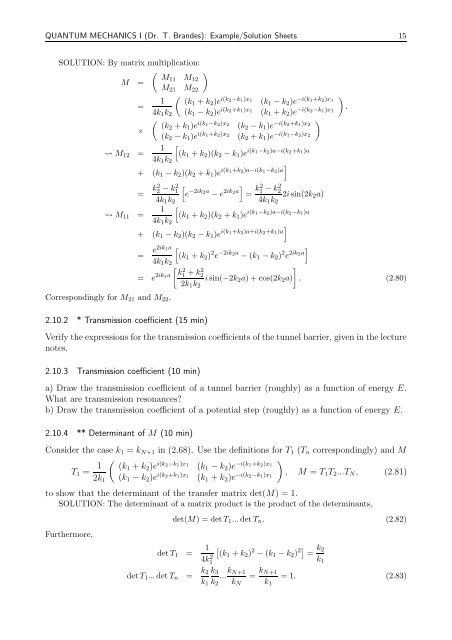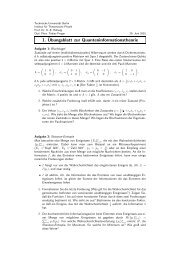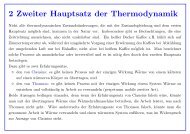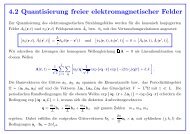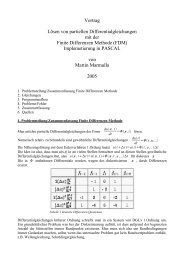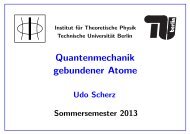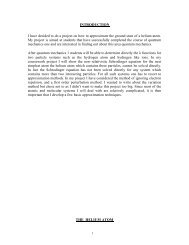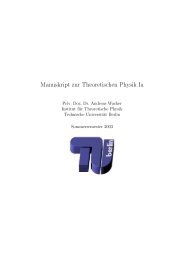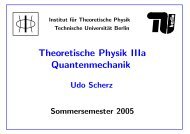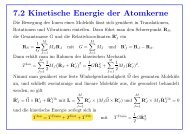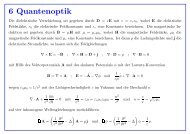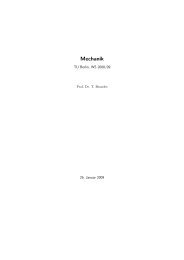1.1 The Radiation Laws and the Birth of Quantum Mechanics
1.1 The Radiation Laws and the Birth of Quantum Mechanics
1.1 The Radiation Laws and the Birth of Quantum Mechanics
You also want an ePaper? Increase the reach of your titles
YUMPU automatically turns print PDFs into web optimized ePapers that Google loves.
QUANTUM MECHANICS I (Dr. T. Br<strong>and</strong>es): Example/Solution Sheets 15<br />
SOLUTION: By matrix multiplication:<br />
( )<br />
M11 M<br />
M =<br />
12<br />
M 21 M 22<br />
(<br />
1 (k1 + k<br />
=<br />
2 )e i(k 2−k 1 )x 1<br />
(k 1 − k 2 )e −i(k )<br />
1+k 2 )x 1<br />
4k 1 k 2 (k 1 − k 2 )e i(k 2+k 1 )x 1<br />
(k 1 + k 2 )e −i(k 2−k 1 )x 1<br />
.<br />
( (k2 + k<br />
×<br />
1 )e i(k 1−k 2 )x 2<br />
(k 2 − k 1 )e −i(k )<br />
2+k 1 )x 2<br />
(k 2 − k 1 )e i(k 1+k 2 )x 2<br />
(k 2 + k 1 )e −i(k 1−k 2 )x 2<br />
1<br />
[<br />
M 12 = (k 1 + k 2 )(k 2 − k 1 )e i(k 1−k 2 )a−i(k 2 +k 1 )a<br />
4k 1 k 2 ]<br />
+ (k 1 − k 2 )(k 2 + k 1 )e i(k 1+k 2 )a−i(k 1 −k 2 )a<br />
= k2 2 − k2 [<br />
]<br />
1<br />
e −2ik2a − e 2ik 2a<br />
= k2 1 − k2 2<br />
2i sin(2k 2 a)<br />
4k 1 k 2 4k 1 k 2<br />
1<br />
[<br />
M 11 = (k 1 + k 2 )(k 2 + k 1 )e i(k 1−k 2 )a−i(k 2 −k 1 )a<br />
4k 1 k 2 ]<br />
+ (k 1 − k 2 )(k 2 − k 1 )e i(k 1+k 2 )a+i(k 2 +k 1 )a<br />
Correspondingly for M 21 <strong>and</strong> M 22 .<br />
2.10.2 * Transmission coefficient (15 min)<br />
= e2ik 1a [<br />
]<br />
(k 1 + k 2 ) 2 e −2ik2a − (k 1 − k 2 ) 2 e 2ik 2a<br />
4k 1 k 2<br />
[<br />
= e 2ik 1a k<br />
2<br />
1 + k2<br />
2 ]<br />
i sin(−2k 2 a) + cos(2k 2 a) . (2.80)<br />
2k 1 k 2<br />
Verify <strong>the</strong> expressions for <strong>the</strong> transmission coefficients <strong>of</strong> <strong>the</strong> tunnel barrier, given in <strong>the</strong> lecture<br />
notes.<br />
2.10.3 Transmission coefficient (10 min)<br />
a) Draw <strong>the</strong> transmission coefficient <strong>of</strong> a tunnel barrier (roughly) as a function <strong>of</strong> energy E.<br />
What are transmission resonances<br />
b) Draw <strong>the</strong> transmission coefficient <strong>of</strong> a potential step (roughly) as a function <strong>of</strong> energy E.<br />
2.10.4 ** Determinant <strong>of</strong> M (10 min)<br />
Consider <strong>the</strong> case k 1 = k N+1 in (2.68). Use <strong>the</strong> definitions for T 1 (T n correspondingly) <strong>and</strong> M<br />
T 1 = 1 ( )<br />
(k1 + k 2 )e i(k 2−k 1 )x 1<br />
(k 1 − k 2 )e −i(k 1+k 2 )x 1<br />
2k 1 (k 1 − k 2 )e i(k 2+k 1 )x 1<br />
(k 1 + k 2 )e −i(k 2−k 1 )x 1<br />
, M = T 1 T 2 ...T N , (2.81)<br />
to show that <strong>the</strong> determinant <strong>of</strong> <strong>the</strong> transfer matrix det(M) = 1.<br />
SOLUTION: <strong>The</strong> determinant <strong>of</strong> a matrix product is <strong>the</strong> product <strong>of</strong> <strong>the</strong> determinants,<br />
Fur<strong>the</strong>rmore,<br />
det(M) = det T 1 ... det T n . (2.82)<br />
det T 1 = 1 [<br />
4k1<br />
2 (k1 + k 2 ) 2 − (k 1 − k 2 ) 2] = k 2<br />
k 1<br />
det T 1 ... det T n = k 2<br />
k 1<br />
k 3<br />
k 2<br />
... k N+1<br />
k N<br />
= k N+1<br />
k 1<br />
= 1. (2.83)


